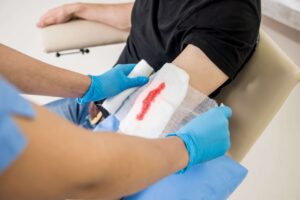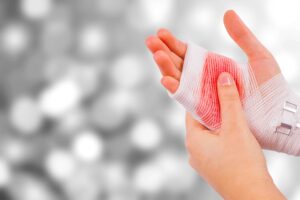From minor wounds like skinned knees to severe injuries like gunshot wounds, everyone experiences traumatic wounds at some point in their life. Traumatic wounds are defined as sudden acute (ripped or torn skin), cuts/lacerations, or puncture wounds (penetrating, stabbing, gunshot) which cause damage to the skin and underlying tissues.
While the body has a remarkable ability to generate new skin and heal minor wounds, more major wounds can develop into chronic wounds and pose a serious risk of infection. And the longer the injury stays untreated the greater the risk of infection.
 That’s why it’s imperative if you or someone you know has suffered from a traumatic injury to reach out to a wound care specialist to diagnose and treat it as soon as possible. This is even more important if you have a weakened immune system or underlying comorbidities that can impair healing like diabetes.
That’s why it’s imperative if you or someone you know has suffered from a traumatic injury to reach out to a wound care specialist to diagnose and treat it as soon as possible. This is even more important if you have a weakened immune system or underlying comorbidities that can impair healing like diabetes.
Let’s take a deeper look at some of the most common types of traumatic wounds and effective treatment options available to you that can promote healing.
What Is a Traumatic Wound?
According to a study of experts in the field and Emergency Physicians, published in the World Journal of Emergency Surgery, traumatic wounds can be classified by:
- Traumatic Wounds caused by trauma but do not present signs of infection and are less likely to develop into an infection.
- Dirty Traumatic Wounds caused by trauma that are macroscopically contaminated. A few examples of these types of wounds can include animal bites, slow healing wounds, and puncture wounds.
- Infected Traumatic Wounds caused by trauma that already show signs of infection.
Types of Traumatic Wounds
 Accidents and violence are strongly associated with traumatic wounds. Examples can include falls, road traffic accidents, domestic accidents, trips, burns (electrical, heat, chemical, or cold), gunshot wounds, and incidents involving machinery, among other things. The type of traumatic wound primarily depends on the cause of injury and the way it presents itself on the body.
Accidents and violence are strongly associated with traumatic wounds. Examples can include falls, road traffic accidents, domestic accidents, trips, burns (electrical, heat, chemical, or cold), gunshot wounds, and incidents involving machinery, among other things. The type of traumatic wound primarily depends on the cause of injury and the way it presents itself on the body.
Each type of traumatic injury comes with its own set of risks. For example, Clostridium Tetani is a bacteria found in soil, dust, and metal objects. Injuries with nails and other metal objects or scraping against dirty surfaces like roads enhance your risk of contracting Tetanus. It’s also important to note, that multiple types of wounds can occur from a single source of trauma.
Abrasions
When your skin slides and rubs against a rough surface or debris like sand, metal, gravel, or glass, an abrasion may occur. Abrasions are partial thickness wounds that can range from smaller injuries like a scraped knee to scrapes that cover a large area of the body.
Although this type of skin scraping generally produces little blood, foreign contaminants can become lodged in the wound/tissue. Unless an infection develops or a large amount of skin is involved, these types of traumatic injuries are often less intensive than other wounds.
Lacerations and Skin Tears
A laceration is a tear or deep opening in the skin, often caused by metal, glass, or wood. Lacerations can be characterized by jagged, irregular edges with the severity depending on the site, cause, depth, and size. Lacerations can range from little to heavy bleeding and various levels of tissue damage.
Skin tears are an example of a specific type of laceration. Often occurring among the older population due to the increasing fragility of the skin, skin tears are caused by friction separating the skin. Skin tears can be partial thickness or full thickness where both layers of the skin become separated.
Incisions
As opposed to the rough and uneven edges of a laceration, an incision is a straight and clean-edged cut in the skin often caused by a knife. You may have heard of surgical incisions, whose clean cuts resemble injuries from razor blades, knives, broken glass, and other sharp objects. Incisions can cause quick and heavy bleeding and generally require stitches.
Puncture Wounds
Puncture wounds are characterized as a hole in the soft tissue. These wounds can range from smaller injuries such as stepping on a nail to much larger wounds like that from a gunshot. In most cases, puncture injuries are deeper than they are wide.
Nevertheless, this hole can damage deep muscles and internal organs, and depending on the source could present as significant bleeding. As you can imagine, gunshot wounds are particularly dangerous, given the sheer force they generate and the potential presence of both entry and exit wounds.
Avulsions and Bites
Forcefully tearing away skin and its underlying tissue can cause an avulsion. Avulsions are deep wounds accompanied by heavy bleeding and missing tissue. Violent accidents such as motor vehicle accidents, explosions, body-crushing injuries, and animal attacks are common causes of avulsions.
Animal bites from creatures like dogs, rodents, cats, and snakes penetrate the skin and besides the damage described above, they pose a serious threat of infection. It’s important to identify the cause of a bite wound, as different sources can result in different types of bacteria or toxins. For example, a human bite could transmit Staphylococcus Aureus and Streptococci, as well as blood-borne diseases like HIV and Hepatitis.
Signs of Infection From A Traumatic Wound
Identifying a traumatic wound can be relatively straightforward after identifying the source, with common symptoms such as redness, bleeding, and pain, but as discussed above, it’s crucial to look out for signs of infection. Bacteria accumulate on the skin’s surface, and open wounds are the perfect opportunity for them to infiltrate. Signs of an infection can include:
- Warm and flushed skin
- Exacerbating pain
- Blisters and sores
- Increased fluid, pus, and drainage that is green, brown, or yellow
- Foul odor
- Fever
- Swollen lymph nodes (lump in groin or armpit)
- Delayed healing
Treatment For Traumatic Wounds
 Because the cause and severity of traumatic wounds can vary, treatment approaches can also differ. Depending on the injury, treatment can range from simply cleaning and dressing the wound to more severe cases that require surgical interventions. That said, generally, the treatment goals for traumatic wounds involve stopping the bleeding, preventing infection, and maximizing functional/cosmetic outcomes by repairing the damage.
Because the cause and severity of traumatic wounds can vary, treatment approaches can also differ. Depending on the injury, treatment can range from simply cleaning and dressing the wound to more severe cases that require surgical interventions. That said, generally, the treatment goals for traumatic wounds involve stopping the bleeding, preventing infection, and maximizing functional/cosmetic outcomes by repairing the damage.
If you have suffered a minor wound and it’s bleeding the first thing to do is stop the flow of blood. Use a clean cloth or bandage to apply gentle pressure on the wound. If it’s on a limb, you can elevate it so gravity slows blood flow as well. If there is a lot of bleeding and/or it lasts longer than 20 minutes, seek immediate care from a wound care specialist.
Depending on the type of traumatic wound, your specialist may utilize different approaches. For example:
- For lacerations: the injury is cleaned with a sterile saline solution and any debris is removed. Once cleaned, an antibiotic is utilized in order to avoid infection. The wound is then covered with a dressing to protect the area and keep it clean and moist.
- For abrasions: debris is removed and the wound is cleaned with a sterilized gauze pad soaked with water and saline solution. Dressings are then applied.
- Other types of wounds such as puncture wounds often require further treatments and surgical intervention. These types of wounds typically involve an initial incision, extracting foreign matter from the area, and then closing it with stitches or sutures, followed by a dressing. After the traumatic wound itself is treated, your specialist may need to address any secondary medical issues.
A tetanus shot is administered for most traumatic wounds to avoid tetanus infection.
Additional Tips for Caring For Traumatic Wounds
As discussed above, severe traumatic wounds should be diagnosed and treated by a trained wound specialist. However, for more minor injuries there are a few additional steps you can take to promote healing (depending on the cause):
- Stay educated on when it’s best to visit a wound care center or consult a specialist.
- Apply ice to the area if bruised and swollen.
- Over-the-counter drugs like Tylenol (acetaminophen) can be effective for managing pain without an infection. Avoid using aspirin as its anticoagulatory effects can enhance bleeding and delay healing.
- Follow recommendations for changing dressings.
- Be on the lookout for signs of infection.
- Follow recommended wound care practices for caring for stitches.
- Avoid picking at scabs that might develop.
Because traumatic wounds significantly damage skin and soft tissues, it’s always best to try to avoid them. Wear well-fitted and comfortable shoes to avoid exposure to hazardous objects, and be extra careful when working with sharp equipment like scissors, knives, and complex machinery. Adhere to safety protocols and use gloves and eyewear whenever required.
That said, accidents do happen and while some minor traumatic wounds can be taken care of at home as the body works to heal them, more severe injuries take longer to heal and may require the help of a wound care specialist.
If you or someone you know has suffered a traumatic injury the specialized team at West Coast Wound Center is here to help. Book an appointment at our wound care center in Fresno and let us put you on the path to recovery.
